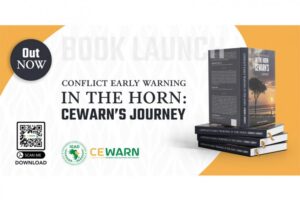Conflict Early Warning in the Horn: CEWARN’s Journey
CEWARN’s new book CONFLICT EARLY WARNING IN THE HORN: CEWARN’s JOURNEY is a comprehensive but eclectic collection of perspectives on the inception and evolution of the CEWARN conflict early warning mechanism over two-decades. Its content covers the mechanism’s experiences, methodological development, accomplishments and challenges in conflict prevention and mitigation – especially pertaining to its first phase of operations on cross border pastoral conflict. It also includes some reflections on CEWARN’s expanded operations and its future prospects.
The content was developed through a diverse set of methodologies including commissioned articles on relevant themes from experts; interviews of over 50 CEWARN stakeholders from all member states ranging from field monitors to high- level officials; travelogues by a commissioned writer from some of CEWARN’s areas of operation as well as methodological articles on the CEWARN system, maps and vignettes.
It targets a broad audience that includes policymakers and diplomats in the Horn of Africa and abroad, informed citizens interested in peace and security issues in the region, peace workers, conflict analysts and early warning experts, and the project’s development partners.
Reviews
As the Special Envoy for the Horn of Africa, I am honoured to endorse this timely and insightful book, which contains a comprehensive collection of perspectives on the inception and evolution of CEWARN. The book targets a multi-faceted audience including policymakers and conflict analysts, and by documenting CEWARN’s unique journey it helps focus on the kind of support needed to enhance regional conflict prevention and peace building efforts in the IGAD region.
Ambassador Parfait Onanga-Anyanga, Special Envoy of the United Nations Secretary-General for the Horn of Africa
The publication of Conflict Early Warning in the Horn: CEWARN’s Journey, could not be more timely. Today more than ever this kind of practical wisdom is needed. Based on both theory and deep reflective practice, these authors provide insight, strategy, vision for how early warning analysis and timely response can mitigate and address repeated patterns of violence conflict. From the grassroots to wider regional conflicts, this book offers practical insight into the challenges and what is being done to address them. It demonstrates how we can effectively coordinate communication and information in order to effectively both prevent violence and transform conflict. This compendium of best practices should be read and put into practice by leaders across the Horn of Africa.
Dr. John Paul Lederach, Professor Emeritus of International Peace building, University of Notre Dam.
CEWARN’s initial focus on pastoral conflicts in border areas positioned it to address and to support the interdependence among these communities through its early warning mechanism and complementary programmes. CEWARN proceeded to play a unique role in institutionalising peacebuilding and conflict management in the IGAD Member States by establishing a regional network of national conflict early warning and response units. CEWARN’s most important contribution, however, is the conceptualisation of a long-term strategy for peace and security. The lessons contained in the book provide invaluable insight into the region’s increasingly complex security challenges, a domain that has long been an exclusive preserve of actors in uniform and state decision makers. As someone privileged to watch the organisation grow since its inception, I can underscore the efficacy of CEWARN’s pioneering approach based on grass-roots agency, information sharing, and empowering the voices of those most affected by conflicts on the ground.
Ambassador Mahboub Maalim, Former Executive Secretary of the Intergovernmental Authority on Development
“Only few know that much of CEWARN’s early design work was done in the Old Truman Brewery in East London. This was where the Forum on Early Warning and Early Response (FEWER) then had its headquarters. FEWER was a global network of conflict early warners and responders. It was uniquely placed to support IGAD’s drive to establish CEWARN. And for CEWARN’s design, FEWER convened a team that combined academic rigour, political acumen, and deep field insight to the task. Howard Adelman, Bethuel Kiplagat, Josephine Odera, Susan Schmeidl, and Ciru Mwaura put response at the heart of CEWARN. As CEWARN took form, it was further developed by dedicated teams at HQ and in the field to place it on the cutting edge of this field. Indeed, many of the field-based and response-focused EWER systems we see today are inspired by CEWARN. There are not many books like this. Indeed, I am delighted that this book has been written. If there is a criticism, then it would simply be that writing it was overdue.
